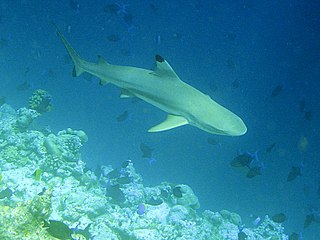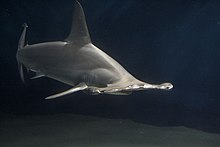
The hammerhead sharks are a group of sharks that form the family Sphyrnidae, named for the unusual and distinctive form of their heads, which are flattened and laterally extended into a cephalofoil. The shark’s eyes are placed one on either end of this T-shaped structure, with their small mouths directly centered and underneath. Most hammerhead species are placed in the genus Sphyrna, while the winghead shark is placed in its own genus, Eusphyra. Many different— but not necessarily mutually exclusive—functions have been postulated for the cephalofoil, including sensory reception, manoeuvering, and prey manipulation. The cephalofoil gives the shark superior binocular vision and depth perception.

Requiem sharks are sharks of the family Carcharhinidae in the order Carcharhiniformes. They are migratory, live-bearing sharks of warm seas and include such species as the bull shark, lemon shark, spinner shark, blacknose shark, blacktip shark, grey reef shark, blacktip reef shark, silky shark, dusky shark, blue shark, copper shark, oceanic whitetip shark, and whitetip reef shark.

The great hammerhead is the largest species of hammerhead shark, belonging to the family Sphyrnidae, attaining an average length of 4.6 m (15 ft) and reaching a maximum length of 6.1 m (20 ft). It is found in tropical and warm temperate waters worldwide, inhabiting coastal areas and the continental shelf. The great hammerhead can be distinguished from other hammerheads by the shape of its "hammer", which is wide with an almost straight front margin, and by its tall, sickle-shaped first dorsal fin. A solitary, strong-swimming apex predator, the great hammerhead feeds on a wide variety of prey ranging from crustaceans and cephalopods, to bony fish, to smaller sharks. Observations of this species in the wild suggest that the cephalofoil functions to immobilize stingrays, a favored prey. This species has a viviparous mode of reproduction, bearing litters of up to 50 pups every two years.

The winghead shark is a species of hammerhead shark, and part of the family Sphyrnidae. Reaching a length of 1.9 m (6.2 ft), this small brown to gray shark has a slender body with a tall, sickle-shaped first dorsal fin. Its name comes from its exceptionally large "hammer", or cephalofoil, which can be as wide as half of the shark's total length. The function of this structure is unclear, but may relate to the shark's senses. The wide spacing of its eyes grants superb binocular vision, while the extremely long nostrils on the leading margin of the cephalofoil may allow for better detection and tracking of odor trails in the water. The cephalofoil also provides a large surface area for its ampullae of Lorenzini and lateral line, with potential benefits for electroreception and mechanoreception, respectively.

The smooth hammerhead is a species of hammerhead shark, and part of the family Sphyrnidae. This species is named "smooth hammerhead" because of the distinctive shape of the head, which is flattened and laterally extended into a hammer shape, without an indentation in the middle of the front margin. Unlike other hammerheads, this species prefers temperate waters and occurs worldwide at medium latitudes. In the summer, these sharks migrate towards the poles following cool water masses, sometimes forming schools numbering in the hundreds to thousands.

The smalleye hammerhead, also called the golden hammerhead or curry shark, is a small species of hammerhead shark in the family Sphyrnidae. This species was historically common in the shallow coastal waters of the western Atlantic Ocean, from Venezuela to Uruguay. It favors muddy habitats with poor visibility, reflected by its relatively small eyes. Adult males and juveniles are schooling and generally found apart from the solitary adult females. Typically reaching 1.2–1.3 m (3.9–4.3 ft) in length, this shark has a unique, bright golden color on its head, sides, and fins, which was only scientifically documented in the 1980s. As in all hammerheads, its head is flattened and laterally expanded into a hammer-shaped structure called the cephalofoil, which in this species is wide and long with an arched front margin bearing central and lateral indentations.

The bonnethead, also called a bonnet shark or shovelhead, is a small member of the hammerhead shark genus Sphyrna, and part of the family Sphyrnidae. It is an abundant species in the littoral zone of the North Atlantic and the Gulf of Mexico, is the only shark species known to display sexual dimorphism in the morphology of the head, and is the only shark species known to be omnivorous.

The scalloped bonnethead is a rare, little-known species of hammerhead shark in the family Sphyrnidae. Its other common names include the mallethead shark and the crown shark. It is found in tropical and subtropical waters in the eastern Pacific Ocean, from Mexico to Peru, and possibly as far north as the Gulf of California. It frequents inshore habitats over soft bottoms to a depth of 100 m, and also enters mangroves and estuaries.

The scoophead is a little-known species of hammerhead shark, part of the family Sphyrnidae. It inhabits the tropical waters of the western Atlantic Ocean, from Panama to southern Brazil, and in the eastern Pacific Ocean from the Gulf of California to Ecuador, and probably northern Peru, as well. It is found in shallow, inshore habitats.

The blacknose shark is a species of requiem shark, belonging to the family Carcharhinidae, common in the tropical and subtropical waters of the western Atlantic Ocean. This species generally inhabits coastal seagrass, sand, or rubble habitats, with adults preferring deeper water than juveniles. A small shark typically measuring 1.3 m (4.3 ft) long, the blacknose has a typical streamlined "requiem shark" shape with a long, rounded snout, large eyes, and a small first dorsal fin. Its common name comes from a characteristic black blotch on the tip of its snout, though this may be indistinct in older individuals.

The scalloped hammerhead is a species of hammerhead shark in the family Sphyrnidae. It was originally known as Zygaena lewini. The Greek word sphyrna translates into "hammer" in English, referring to the shape of this shark's head, which is its most distinguishing characteristic. The shark's eyes and nostrils are at the tips of the extensions. It is a fairly large hammerhead, but is still smaller than both the great and smooth hammerheads.

Aega psora is a species of isopod crustacean that parasitises a number of fish species in the North Atlantic. It is a serious ectoparasite of larger species of fish, particularly when they are injured.
The Carolina hammerhead is a species of hammerhead shark, and part of the family Sphyrnidae, found in the western Atlantic Ocean. Their pupping grounds are in nearshore waters off the southeastern U.S. with the highest concentrations found in Bulls Bay, South Carolina. The Carolina hammerhead has also been found in nearshore waters off of Brazil. It was formally described in 2013.

Tokyo Sea Life Park is a public aquarium located in Edogawa Ward, Tokyo. It is located in Kasai Rinkai Park in Edogawa Ward, Tokyo, and Kasai Rinkai Bird Garden is also located in the park. It can be accessed from Kasai-Rinkai Park Station. The Predecessor is the Ueno Aquarium, which was set up in the Ueno Zoo. The building was designed by Yoshio Taniguchi.
Ornithoteuthis volatilis, the shiny bird squid, is a squid from the subfamily Ommastrephinae, the flying squids, of the family Ommastrephidae part of the pelagic squid order Oegopsida. It is a tropical and sub-tropical species which is widely distributed in the Indo-Pacific oceans. It is slightly larger than the closely related species Ornithoteuthis antillarum of the Atlantic Ocean.

The Tstsikamma Marine Protected Area is a marine protected area on the south coast of South Africa, in both the Western Cape and Eastern Cape. It is on the coast of the Tsitsikamma National Park, and is one of the oldest MPAs in the country. The MPA provides protection for marine habitat and wildlife, including birds and threatened and endangered fish species.















